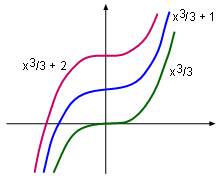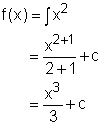| Ch 6. Integrals | Multimedia Engineering Math | ||||||
|
Indefinite Integral |
Area |
Definite Integral |
Fundamental Theorem |
Substitution Rule |
|||
| Indefinite Integral | Case Intro | Theory | Case Solution |
| Chapter |
| 1. Limits |
| 2. Derivatives I |
| 3. Derivatives II |
| 4. Mean Value |
| 5. Curve Sketching |
| 6. Integrals |
| 7. Inverse Functions |
| 8. Integration Tech. |
| 9. Integrate App. |
| 10. Parametric Eqs. |
| 11. Polar Coord. |
| 12. Series |
| Appendix |
| Basic Math |
| Units |
| eBooks |
| Dynamics |
| Fluids |
| Math |
| Mechanics |
| Statics |
| Thermodynamics |
| ©Kurt Gramoll |
| |
||||||||||||||||||||||
This section discusses the concept of antiderivative and the theorms related to it. |
||||||||||||||||||||||
| Antiderivative |
||||||||||||||||||||||
A derivative provides an easy way to find the rate of changes for a function. On the other hand, an antiderivative is a way to find the function of a given derivative. An antiderivative of a function f is any function F such that F' = f. It is a reverse process of differentiation. |
||||||||||||||||||||||
| Indefinite Integral |
||||||||||||||||||||||
The notation used to refer to antiderivative is the indefinite integral. ∫f(x)dx means the antiderivative of f with respect to x . If F(x) is an antiderivative of f(x), then ∫f(x)dx = F + c in which c is an arbitrary constant. |
||||||||||||||||||||||
|
The table on the left gives various examples of indefinite integrals. The method to calculate the antiderivative or indefinite integral can be better understand by finding the antiderivative of function f '(x) = x2 when f(1) = 7/3. The indefinite integral rules gives that The antiderivative of the given function f '(x) = x2 can be expressed as In order to determine the constant c, substituting f(1) = 7/3 into the above expression. f(1) = 1/3 + c = 7/3 |
|||||||||||||||||||||
 Family of Curves for f(x) = x3/3 + c |
Rearranging the above equation gives c = 2 Therefore, the solution of this example is f(x) = x3/3 + 2 Notice that the f(x) = x3/3 + c is a family of functions and a specific function depends of the given intial condition or boundary condition. Its graphic is shown on the left. |
|||||||||||||||||||||

